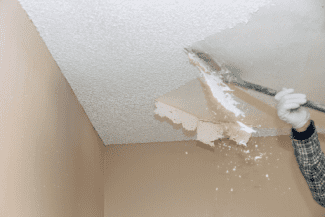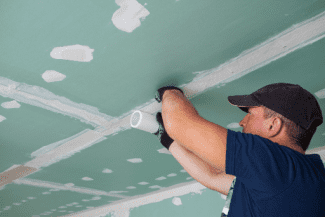Popcorn ceiling removal: What it takes
Key takeaways
-
Popcorn ceiling removal is an extremely messy task
-
Testing for asbestos must be done before removing a popcorn ceiling
-
Covering the “popcorn” with a whole new ceiling may be a better option

In fact, a popcorn ceiling is one of the main signs that your home is “hopelessly outdated,” according to Realtor.com, a publication of the National Association of Realtors.
Unfortunately, removing popcorn ceilings isn’t an easy task. That’s partly because they may contain another relic of the past: dangerous asbestos fibers. As a result, many people decide to cover those ugly bumps with a whole new ceiling layer, because it can be easier and safer than removing the popcorn itself.
In this article, you’ll learn what’s required to remove or cover an acoustic ceiling—and why, in most cases, you’ll want to get help from a professional.
The problem with popcorn
The “popcorn” on a ceiling is actually a thick coating that was sprayed or brushed onto flat drywall (also known as gypsum wallboard, or the popular brand Sheetrock—the same material you’d use for a wall). This bumpy layer consists of a water-based, paint-like substance, mixed with either paper, Styrofoam, or the mineral vermiculite.
Beginning in 1945, builders began to favor this coating because it reduced construction costs. It could be applied quickly and easily, didn’t need to be painted over, and the popcorn texture hid a world of drywall imperfections—such as irregular joints, seams between drywall panels, and hammer dents from nailing.
The irregular texture also had sound-dampening (“acoustic”) properties, making it a popular choice for bedrooms, living rooms, and hallways. But, over time, homeowners discovered that popcorn ceilings were difficult to keep clean. And the bumpy texture made rooms dimmer by reducing light reflection.
The worst problem? Some coating formulations contained a potentially dangerous substance, asbestos.
The Clean Air Act of 1978 banned new production of texture coatings that contained asbestos, but existing stock could still be used. That means ceilings installed as recently as the 1980s may contain asbestos fibers.
Eventually, the asbestos in popcorn coatings was replaced by nontoxic materials. But the ceilings themselves waned in popularity and eventually became passé, as design trends evolved toward smooth ceilings that look more modern and are easier to clean.
As a result, popcorn ceiling removal is among the top makeovers requested by homeowners today.
Testing your ceiling for asbestos
Asbestos is a heat-resistant mineral found in rocks and soil. If inhaled, its fibers can lodge in your lungs. That can lead to a certain type of cancer, called mesothelioma, as well as lung cancer and other diseases.
If you disturb a popcorn ceiling that contains asbestos, the material may crumble, releasing harmful dust into the air. That’s why removing it—or even just testing the ceiling to see if it has asbestos—requires extreme caution.
There are two ways to test for asbestos in a popcorn coating:
-
Buy a mail-in asbestos test kit. You can get these online or at hardware stores or home-improvement centers for $30–65. Be sure the kit is approved by the Environmental Protection Agency (EPA), and follow the safety instructions that come with it to the letter. (If there’s any question about whether you can do this correctly, don’t try to test it yourself.) In most cases, you’ll scrape a small piece of ceiling texture into a plastic bag, seal the bag, and send the sample to a certified testing lab.
-
Get your ceiling professionally examined by an asbestos testing company. This typically costs about $500, but it’s safer and more reliable than DIY testing. You can find specialists in your area through the EPA’s State Asbestos Contacts website, or search for asbestos testing companies that are licensed and certified. Some companies that remove popcorn ceilings may also do the testing themselves. But to avoid a conflict of interest, it’s a good idea to have one company test and a different company do removal work.
The simplest solution: Cover it up

The easiest way is to cover it up by adding a second ceiling over the existing one, which hides the popcorn material. You can do this yourself or hire a professional.
You can add a second ceiling whether or not your ceiling contains asbestos. But have the popcorn tested beforehand, because it’s difficult to do after the new ceiling is installed.
Pro tip: If your ceiling contains asbestos, placing a new ceiling under it is actually safer than removing the popcorn material, according to the Consumer Product Safety Commission (CPSC). The idea is to cover it up while disturbing the surface as little as possible, so the fibers are less likely to become airborne.
You can cover over a ceiling with material such as:
-
A second layer of drywall
-
Wood paneling, coffered paneling (which features indented patterns), or planks
-
Decorative acoustic ceiling panels
-
Metal ceiling tiles
If this is more than you can handle yourself, hire a drywall contractor or ceiling contractor for the job. Expect to pay $2.50 or more per square foot for materials and labor.
Can you DIY a ceiling cover-up?
If you have the skills and tools for installing drywall, you might be able to add a layer of ceiling as a DIY project. (If the ceiling has asbestos, only do this if you can be sure you won’t disturb the original popcorn coating.) It’s a two-person job, so you’ll need a helper.
If you take on this challenge, you should:
-
Buy ultra-lightweight drywall.
-
Rent a drywall lift to ease the job of lifting panels.
-
Attach the panels with screws that go through the existing drywall layer and penetrate into the ceiling joists.
How pros remove a popcorn ceiling
The alternative to covering the popcorn ceiling is to remove it, leaving the drywall underneath. If the material contains asbestos, this must be done by a licensed asbestos-abatement professional (see below). But even if it doesn’t, it’s a big job, which most homeowners will want to leave to the experts.
When first installed, the popcorn ceiling may have been used to hide poorly covered drywall joints and other imperfections. That means the drywall will likely need some patching and sanding—both because of the imperfections beneath the texture, and because of nicks and scrapes that may occur during removal. The entire ceiling will also need priming and a fresh coat of paint, because it probably wasn’t painted before.
Although most pros have their own process for getting rid of asbestos-free popcorn ceilings, the work typically goes like this:
-
Protect floor, baseboards, and lower parts of walls with rosin paper (a heavy-duty felt paper used on work sites) or heavy-duty plastic drop cloths. The walls are often draped with lightweight plastic sheeting, too.
-
Open windows to provide ventilation. Turn off power to the electrical outlets, ceiling fans, and light fixtures at the circuit-breaker panel. Ceiling light fixtures are usually removed.
-
Wearing dust masks, pros will test a small area in one corner of the ceiling to see if the texture can be scraped off dry. If it doesn’t come off easily with the scraper, they’ll wet it with a pump sprayer, garden sprayer, or spray bottle of warm water, and wait about 15 minutes for the texture to soak up the liquid.
-
Then the scraping begins. They’ll usually work in small sections—about 2×2 feet. The goal is to loosen the texture without damaging drywall by oversoaking it. Moisture is reapplied as required to release the texture.
-
When scraping is finished, they’ll gather up all the drop cloths and dispose of them.
-
Once the whole ceiling dries completely, they’ll fill holes and gouges, repair drywall joint tape, and apply a smooth texture.
-
Last but not least, they’ll prime and paint the ceiling.
Can you DIY popcorn removal?
If you have good DIY skills and a few tools, it may be possible for you to remove an asbestos-free popcorn ceiling. But be ready for a difficult, extremely messy task. In most cases, the ceiling must be sprayed with a lot of water to release the mud-like paint substance.
Once you begin scraping the ceiling, globs of muddy material will fall to the floor. You’ll need to prepare for this by clearing the room of furnishings, drapes, and other objects. Then, follow the process discussed above.
Pro tip: If your popcorn ceiling is made with asbestos, never try to remove it yourself. Attempting to scrape off the material could release fibers into the air, causing serious health risks for you and your family.
Hiring a pro
Hiring a professional to remove your popcorn ceiling depends, in part, on whether or not asbestos is present.
Follow these general hiring tips:
-
Verify that the painter, drywall contractor, or ceiling specialist is licensed, bonded, and insured.
-
Ask friends and neighbors for recommendations, and search online reviews.
-
Get three quotes to compare. But be wary of someone who gives quotes over the phone before diagnosing the problem.
-
Ask the contractor to inform you of any safety issues or inconveniences for you and your family.
If the ceiling doesn’t contain asbestos
The professionals who do non-asbestos popcorn ceiling removal include painting contractors, drywall contractors, and general contractors. In some cases, they’ll be popcorn ceiling removal specialists.
Cost can vary widely, depending on size of the ceiling and local labor prices. Expect to pay around $1.50–3 per square foot for removing an asbestos-free popcorn ceiling.
If the ceiling contains asbestos
In this case, you absolutely must hire a qualified professional to remove it. Federal law doesn’t require certification, but many state laws do.
A professional asbestos abatement contractor will typically charge $3–9 per square foot to remove the popcorn ceiling, or several thousand dollars for the entire home.
Source: Yelp















 Accessibility
Accessibility